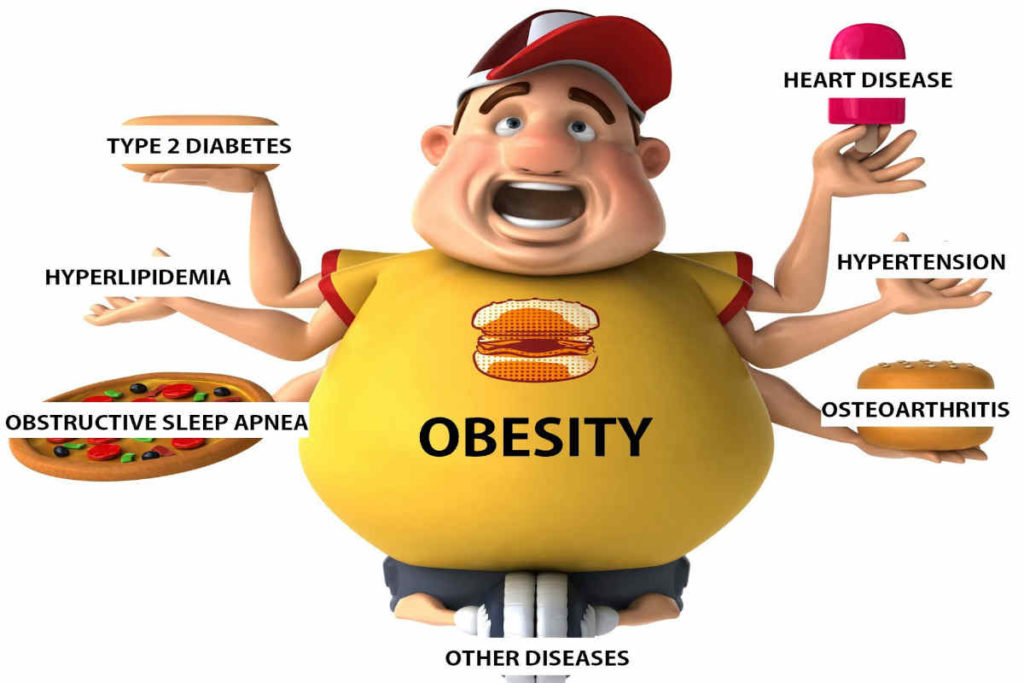Everything Health Support Groups
These inspiring stories of those who have overcome Cancer will keep you motivated

Childhood obesity is becoming common these days. Eating unhealthy and less nutritious food is a major contributing factor. India has the second largest number of obese children in the world and it is estimated that by 2025 this number is estimated to grow by 70 million. On one hand many children in our country are deprived of right amounts of foods, on the other hand some children are facing obesity as a major concern.
According to Mona – “Childhood obesity results primarily due to limited or no outdoor activity, high calorie intake and irregular eating habits of children.”
In Indian society a chubby child is regarded as healthy. Whereas a chubby child does not mean that the child is healthy.
Childhood Obesity Complications
Childhood obesity can lead to serious complications such as:
Mona says- “Childhood obesity is not a result of genetics, whereas it is actually a result of parent’s behavior, if parents are eating unhealthy the child will mimic the same and ultimately becomes obese as his/her parent.”
Right Food for Obese Children
Mona does not recommend low fat food in children as the process of making a low fat food involves extracting the fat content and replacing it with refined carbohydrates to make it palatable. Refined carbohydrates are bad for the health and causes obesity.
Mona says- “Combine the foods to make it more nutritious and healthy. Example-If you are giving aloo parantha to child club it with yogurt and butter to make it more nutritious. Instead, try giving a vegetable parantha like gobhi or mooli parantha.”
Food During Exams
As parents we feed the child with whatever food he/she asks for especially during the exam time. Mona says -It is important to replace high carbohydrate food with foods rich in phytonutrients, omega- 3 fatty foods, extra virgin olive oil, and antioxidants.
These foods supplement optimum nutrition and improve the performance of the child. Foods high in carbohydrates kill gut micro biome.
Value of Rainbow Food
Mona suggests eating rainbow foods at an early age to all children. This includes eating different colored fresh fruits and vegetables. This supplies children with essential phytonutrients, vitamins and minerals. Eating unprocessed foods, fatty fish (a rich source of omega-3), and cereals aids healthy nutrition in children
Power Food-Simple and Easy Early Breakfast Recipe
Berry smoothie- Make simple smoothie which contains flax seeds, berries, yogurt and little bit of honey. This is an ideal food for kids, as it contains good combination of macros.
Foods to Completely Avoid
Below is the list of some foods which are to be completely avoided
Foods to be Given to Children in Moderation
Food Essential for Growth and Development
Mona says- “Calcium is one mineral essential during early development years. Maximum calcium requirement is there during 9-18 years of age. 1000 mg/day is the essential requirement of the child during this phase.”
Foods rich in calcium are
To read more on Obesity, click on the link below.

Obesity is a multifaceted health disorder that affects both adults and children. Being obese not only affects the overall persona of an individual but also increases the risk for many health concerns. An obese person is at a higher risk of developing health conditions like diabetes, heart disease, stroke, arthritis, breathing problems, and some cancers.
Statistics have revealed that obesity is a major factor contributing factor for metabolic syndrome and type 2 diabetes mellitus (T2DM) among Asian Indians. Various factors contribute towards making an individual obese. Some major factors which contribute towards obesity are environment, family history and genetics, metabolism or the way your body converts food and oxygen into energy, and individual’s lifestyle. Besides these factors certain medical conditions also leads to obesity. Scientists are also trying to understand that some chemicals in the environment may be playing in the growing obesity problem.
Recent guidelines have revealed that 10-15% of Indian population would fall under the obese category and would need appropriate management. Purpose of these guidelines on countrywide basis projects an alarming situation of T2DM and cardiovascular disease.
Some startling facts about obesity:
New guidelines have been proposed in view of alarming situation of obesity among Indians. These guidelines have been prepared by 100 medical experts all across the country hailing from the backgrounds of internal medicine, diabetes, metabolism, endocrinology, nutrition, cardiology, exercise physiology, sports medicine, bariatric surgery and representing reputed medical institutions, hospitals, government funded research institutions. The very need for these guidelines has been enumerated below:
Three parameters which are used to measure obesity are body mass index BMI, waist circumference WC and waist-to-hip circumference ratio (WHR). The most accepted method to define thinness and fatness is BMI, a ratio of weight in kilograms divided by height in meters squared (kg/m2).
After a major consensus among scientists below table has been prepared to depict the obesity among Asian Indians:
| Classification | BMI(kg/m2) | |
| Principal cut-off points | Cut-off pointsfor Asians | |
| Normal range | 18.5 – 24.9 | 18.5 – 22.9 |
| 23.0 – 24.9 | ||
| Pre-obese | 25.0 – 29.9 | 25.0 – 27.4 |
| 27.5 – 29.9 | ||
| Obese (Class I) | 30.0 – 34.9 | 30.0 – 32.4 |
| 32.5 – 34.9 | ||
| Obese (Class II) | 35.0 – 39.9 | 35.0 – 37.4 |
| 37.5 – 39.9 | ||
| Obese (class III) | ≥40.0 | ≥40.0 |
Research has revealed that abdominal obesity is associated with higher risk of diabetes and cardiovascular disease when compared with generalized obesity. Cardiovascular disease is associated with increased amounts of excess abdominal adipose tissue, both intra-abdominal adipose tissue (IAT) and subcutaneous adipose tissue (SCAT). In view of this a joint discussion and consensus among scientists concluded the WC cut off among Asian Indians as defined below:
Obesity could be genetic, behavioral and can also result due to the hormonal changes in the body. Obesity occurs when you take in more calories than you burn through exercise and normal daily activities. Your body stores these excess calories as fat. Some medical conditions also result in obesity such as Prader-Willi syndrome, Cushing’s syndrome, and other diseases and conditions. The main reasons for obesity are either sedentary lifestyle or eating unhealthy such as junk foods at wrong intervals.
What are the risk factors that can contribute to obesity?
Obesity usually results from a combination factors, including:
What are the complications associated with obesity?
A number of health problems arise if you are obese. Some of the diseases which you may encounter include:
Quality of life-If you are obese you are most likely to suffer from other issues, which can severely affect the quality of life. Some common problems which arise due to obesity include depression, disability, sexual problems, shame and guilt, social isolation, and poor performance at workplace
You can take some below-mentioned steps to prevent obesity:
According to joint decision among scientist below is the list of guidelines about physical activity in combating obesity and associated health concerns:
What is the treatment of obesity?
The treatment of obesity includes a combination treatment from a dietitian, behavior counselor or an obesity specialist. Recent guidelines suggest identifying and treating the underlying cause of obesity, lifestyle modification, pharmacological treatment like ant-obesity drugs along with lifestyle modification, and if needed surgical treatment is advisable in treating obesity.
Scientists have concluded that anti-obesity drugs should be prescribed in combination with dietary and lifestyle changes as a part of comprehensive weight loss program. Also, drug treatment should be monitored on an ongoing basis for efficacy as well as safety. In general, anti-obesity drugs should be administered for BMI above 27 kg/m2 or a BMI above 25 kg/m2
Anti-obesity drugs which are recommended to treat obesity are sibutramine, orlistat should be used as a second line therapy. At times metformin and exenatide can be used under special clinical conditions.
Over the past few years bariatric surgery has come out as an option for obesity reduction. Bariatric surgery involves an alteration in the digestive system by reducing the gastric volume or by changing the path of food bolus which can lead to malabsorption. According to current international guidelines below are the guidelines for bariatric surgery:
Various surgical options are available under the umbrella of surgery which includes:
Pros and Cons are associated with above mentioned procedures; however, it is upon the physician to decide that which surgical treatment is best suited for the particular patient.
Having a positive attitude towards weight loss and employing various changes in lifestyle such as exercising and eating a well-balanced diet can help you to lose weight. Nevertheless, obesity remains a rampant problem even in developing nation like India. Appropriate interventions are required in a timely manner to combat this problem to prevent other major health concerns.
These inspiring stories of those who have overcome Diabetes will keep you motivated
As Hippocrates rightly said centuries ago – “Let food be thy medicine and medicine be thy food.” Here we bring you a realm where our food and nutrition expert Dr. Mona Johar tells us about treating food as medicine in a very easy and simple way.
Myth: People with diabetes should never have sweets!

Truth: Good news folks! People with diabetes can have sweets occasionally. American Diabetes Association advocates that desserts and sweets are to be relished and consumed on special occasions and festivals albeit, your blood glucose level are under control and you are taking prescribed medicines regularly.
Myth: People with diabetes cannot have juices.

Truth: People with diabetes can very much enjoy fresh juices, but they definitely need to avoid canned and packed juices because of its added sugar content and high glycaemic values.
Myth: People with diabetes cannot have fruits.

Truth: People with diabetes should offcourse have fruits keeping in mind the glycaemic indexes. According to National Institute of health, USA fruits are a very good source of fibres and vitamin C “ascorbic acid”. All citrus fruits are rich source of vitamin C which boosts our immune system to fight against common diseases.
Myth: A big NO-NO to potatoes

Truth: People with diabetes may have potatoes (baked, grilled or steamed) in meals. Potatoes are to be ideally consumed, along with non-starchy vegetables and salads.
Myth: Diabetes diet is a very strict diet

Truth: A Diabetes diet is one of the healthiest diets, and has no hard and fast rule. Diabetes diet can be even followed by people without diabetes. You may select from a variety of options like the Mediterranean, flexitarian, vegan, Ornish to know more refer to Diet options in Famhealth.
Myth: Say no to all carbohydrates and yes to proteins

Truth: Yes carbohydrates do turn into sugars, but having overload of proteins and no carbs may lead to fatigue and cardiovascular diseases. Having more of proteins eventually leads to accumulation of fats in the body leading to cardiovascular diseases. ADA suggests, making a smart choice of having low carbohydrates will keep you energetic and prevent you from feeling low and tired.
Myth: Diabetes diet does not contain eggs, as they contribute to high cholesterol levels in the body

Truth: People with diabetes may have eggs, as eggs are a good source of protein and vitamin D. ADA says, “What really matters is the way it is cooked”. Boiled eggs with yolks removed can be consumed, to ensure that it does not aid to cardiovascular complications.
Myth: You can eat whatever you want if you are taking medications

Truth: This is one of the major myths associated with diabetes. Medications only help you to convert sugar to energy, but if you supplement your body with more than required amount of food then, it will lead to spiking of blood glucose levels and poor diabetes management.
To read more on Diabetes, click on the link below.

Going for grocery shopping for yourself or your loved one? Take a look at the nutritive items you must bring home and stock up your Frigidaire. Besides nutrient content, the glycemic index (GI) of a food may also help you make healthy choices. The GI measures how quickly a food will raise blood sugar. Low GI foods have a score of 55 or less, while high GI foods have a score of 70 or more. In general, lower GI foods are a better choice for people with diabetes. Foods that are both nutritious and have a low GI are helpful in managing health and blood glucose levels.
Keeping the Indian supermarket in mind we bring together some easily available items extremely beneficial for you health.
Here’s your guide:
Starchy foods:
Starchy foods are always referred Carbohydrate rich foods. This category stands very important as it provides energy to the body to perform vital actions. Whenever you are going to the supermarket next for grocery shopping make sure, a good portion of your cart contains items from this category. So, we bring you some healthy options which can help you to shop quickly. Of course the options given below are not the only options you may choose, but incorporating some or all into your diabetes meal plan may help you and partner improve the overall health.
Non-Starchy
This category of veggies goes a long way in satisfying your hunger and boosting your intake of vitamins, minerals, fibre, and phytochemicals. They are the lowest in calories and carbohydrates. Non starchy vegetables are highly recommended by dieticians around the globe for weight loss and diabetes management.
Here are some non-starchy veggies you may wish to bring home today.
Fruits
You may choose to add non starchy low glycaemic index fruits in all your meals and snacks. They contain natural fructose which may act as a dessert after meals to satisfy your taste buds. According American Diabetes Association guidelines, at least 4-5 servings of fruits needs to be consumed daily by people living with diabetes. They nourish the body with plenty of vitamins and fibres.
These are some options you may choose to shop today.
Dairy products
ADA recommends, we should include dairy products as a part of our healthy diet, as they are high in both protein and calcium. Evidence till date suggests, that milk product consumption is associated with a reduced risk of developing type-2 diabetes. So, we are sharing a list of milk products you may wish to add in your cart. But it’s advisable to check on fats while consuming milk products.
Here are some healthy options.
You may choose to include a variety of protein-rich foods in your diabetes meal plan. Proteins are derived from both animals and plant origin, which are very essential for the repair and growth of human body. As you already know protein also provides energy and is an excellent source of macro nutrient known as the “building blocks of life”.
Here are some healthy choices; you may wish to take home today.
Nuts and Seeds
Research conducted in Louisiana State University found, that people who regularly consumed nuts have lower risks for Type 2 diabetes. So, next time, you crave for foods high in sugar and fat, you have healthier options and can choose to munch on some assorted nuts. It can be an excellent snack option as well, such as pumpkin seeds known to deliver taste and crunch, or peanuts and other seeds which are rich in protein, fibre, and good fats. They’re also a source of magnesium, a mineral that’s key to blood-sugar control because it helps cells use insulin. So, on the basis of their great benefits, we are recommending you these
Oils and Fats
As you may already know, oils and fats are also a very essential part of our diet, as it provides nourishment and a major chunk of cooking is done with them. Oils and fats are a good source of vitamin E, which is important for maintaining healthy skin.
It is true that all fats are high in calories, so it is important to watch portion sizes you are consuming. But a smarter way can be adopted by opting for unsaturated healthy fats than saturated and Trans fats, while substituting the healthy fats in their place.
Here’s a small list of Cooking oil and fats.
Herbs and Spices
The herbs and spices from our Indian sub-continent seem to be the most explored and active component in maintaining blood glucose levels. A number of research and studies are being conducted to support this theory.
Let us find the essential spices and herbs one must have in their kitchen
Beverages
As you may already know, if you are having diabetes, doctors recommend that you have to be aware of everything you eat or drink specially canned or packaged drinks which contain hidden sugars. So to prevent spiking in the blood sugar levels, American Diabetes Association (ADA) recommends choosing zero-calorie or low-calorie drinks.
Here are some options which may benefit you while consuming beverages.
Snacks
Who doesn’t love snacks? Everyone loves to much on snacks in between meals; there are lots of healthy choices that can be used as snack foods. As you may already know, while taking medications you are advised to snack in between meals to avoid low blood sugar levels.
So we bring together some quick readymade snacks you can directly pick from the super market.
Remember this list is not exhaustive you may pick and choose other food items as well, according to their Glycaemic Index. This list is quick shopping guide keeping the Indian market in mind.
To read more on Diabetes, click on the link below.

1. Keep a Diary:
One of the smartest ways to begin with, is to record what you are eating throughout the day. Leading dieticians all-round the globe recommends maintaining your own small diary, to keep a check and analyse the food items you are consuming. Studies in the U.K confirm, people who maintained food records lost extra amount of weight, than people who didn’t record.
2. Watch your food labels:
Picking up a fruit juice can? Or your favourite soft drink? You’re advised to read the nutritive label. Knowing the calorie content and glycaemic index can get a little cumbersome, but research suggests, awareness of the calorie content and high sugar levels help people living with diabetes in keeping away from harmful food items which may spike their blood glucose levels.
3. Start with a good breakfast:
Research is on our side, starting the day with a good breakfast powers you with high energy and helps you maintaining your blood glucose levels throughout the day. The old saying “breakfast like a king” stands correct if you choose low carb breads & cereals, fresh juices, boiled eggs, nuts, oats, yogurt, cheese, milk and not to forget your medicines.
4. Eat by the plate method
Eating by the plate method advocated by ADA recommends, filling half of your plate with non-starchy fruits and vegetables, one fourth of your plate with lean proteins like grilled fish or chicken and the balance with low carbs. This is a popular model which not only aids in weight loss, but also keeps the blood glucose levels on check.
5. Carb counting
Carbohydrate counting, also called carb counting, is not a diet plan, it is a meal planning strategy for people with type 1 or type-2 diabetes. Carbohydrate counting involves keeping track of the amount of carbohydrate in the foods you eat each day.
Carbohydrates are one of the main nutrients found in food and drinks and it is very important. Completely cutting down on carbs may lead to fatigue and restlessness. One must choose wisely and replace with diabetes friendly and healthy low carbs.
According to National Institute of Health USA, healthy carbohydrates, such as whole grains, fruits, and vegetables, are vital part of a healthy eating plan because they provide both energy and nutrients, such as vitamins and minerals, and most importantly fibre. Fibre can help you prevent constipation, lower your cholesterol levels, and control your weight.
Unhealthy carbohydrates are often food and drinks with added sugars. Although unhealthy carbohydrates can also provide energy, they have little to no nutrients and they often spike your blood glucose levels leading to poor diabetes management.
6. Eat more small meals
People with diabetes should eat 4-5 small meals during the day instead of three larger meals, says the American Diabetes Association (ADA). Eating small meals allows replenishment along with slower, continuous absorption of food, which prevents you from cravings and hunger pangs. Among the benefits are also decreased blood sugar levels after meals, reduced insulin requirements during the course of the day, weight loss and lower blood cholesterol.
7. Always stock up your refrigerator:
Stocking up your refrigerator with healthy food items is more or less like keeping your supplies ready. This prevents you from eating high calorie and sugary food items in times of hunger. You may choose from a wide variety of fruits, nuts, cheese, and low carb multigrain breads and protein shakes to quickly make minimeals and avoid binging.
To read more on Diabetes, click on the link below.

Being diagnosed with diabetes can be an overwhelming experience In fact, it can be a major life stress for many people. This is especially true as most chronic conditions and progressive diseases can prove to be quite challenging to manage emotionally.
If you or your family are feeling anxious and disheartened, you should know that it is natural to feel that way. You should also know that you are not alone, and that 70 million other people in India are living with Diabetes. This is a condition that needs to be “managed”.
In brief, Diabetes is characterized by high blood glucose levels that result from defects in the body’s ability to produce enough insulin, and at times no insulin is produced at all. Insulin is required to remove sugars and toxins from our system, and when they do not get flushed out, they tend to accumulate, resulting in high blood glucose levels.
You will be happy to know there are countless cases of people who have reversed their condition simply by making changes in their daily lives, especially when it comes to food, exercise and stress management. With some precautions and care, we are confident that you too can be a winner.
Remember, with a clear plan, appropriate guidance, right (and on time) medications, timely tests and appropriate modifications to your lifestyle you can not only overcome your condition but stay on top of it. To know more, please refer to our Let’s Understand section
Remember, we are here to help you in your endeavour to stay focussed and on target!
As a partner or caregiver, it is understandable that your feel anxious and concerned on hearing the diagnosis of Diabetes.
Please be assured that there is no cause for concern as this is a condition that can be managed with a little care and diligence. You may need to play a pivotal role in the management of the condition for your partner or a loved one and therefore, you would need to be supporting and considerate. Research points to high success rates for diabetics that have had the support of a spouse or family member.
To read more on Diabetes, click on the link below.

High, fluctuating or unmanageable blood glucose levels can be an overwhelming experience. If you have been living with Diabetes for some time now, you would have seen some variation in your blood glucose levels, despite your best efforts. While you and your partner/family may find this alarming or even frustrating, you need to look at the cause beyond the symptom.
Erratic sugar levels occur when either the body is not producing insulin at all or the glucose is accumulating in the body. Other factors, such as harsh weather, stress, hormonal changes, and the lack of physical activity could also cause erratic blood glucose levels. Food intake and sleeping patterns also play a pivotal role in erratic blood glucose levels. Research suggests that lack of sleep or oversleeping also affects blood glucose levels in the body.
If you have been living with diabetes for over a decade, there may be a possibility of you becoming insulin resistant. Whatever may be the case, we urge you to remain calm and reach out to your doctor immediately. Your doctor may change your medication or insulin dosage according to your current blood glucose levels.
While it is true that there are situations that are beyond your control and these lend themselves to spikes in the glucose levels in your body, most of the time, a one-off surge is not a cause of concern. However, you do need to be watchful and keep track to see if there is a pattern to the surges as well as the triggers.
It would help if you can share these observations with your doctor in order to review your treatment plan and required modifications, if any. It is possible that depending on your specific case, the doctor may advise you on how to proceed and be more vigilant with your daily/ pre-meal blood glucose readings.
As per the guidelines set internationally, if your blood glucose levels exceed 300mg/dl for a prolonged time and refuse to dip inspite of best efforts, you need to contact your doctor immediately as high blood glucose levels over a long duration may impact the functioning of other vital organs. You may want to discuss this in detail with your doctor.
We understand as a partner you may become anxious due to your partner’s unmanageable erratic glucose levels. But don’t give up! Identify the key triggers which are leading to spiking of the blood glucose levels in the body.
Sometimes conditions like allergens, harsh weather, stress, anxiety, depression and uncontrolled binging may also lead to erratic glucose levels. However consult with your doctor, your doctor may alter medications and suggest insulin to control erratic blood glucose levels in the body.
Research also hints people living with diabetes for more than a decade tend to develop insulin resistance, which may cause fluctuating uncontrolled blood glucose levels. As a partner you are recommended not to ignore high erratic blood glucose levels and immediately discuss the best possible ways and plans to control blood glucose level with your doctor.
To read more on Diabetes, click on the link below.

Have you been diagnosed with borderline high blood sugar levels? In your case the blood sugar levels recorded are higher than normal, but not high enough to be full-fledged Diabetes. This is referred to as the Prediabetes stage which can be reversed by following recommended guidelines.
During this phase, your pancreatic cells are still producing a little amount of insulin to convert carbohydrates into sugar, however, Insulin produced by the pancreas is not sufficient to remove sugars effectively, keeping the blood glucose level high.
It has been observed that people with Prediabetes may not take this condition seriously. However, research suggests that the sooner one begins to take precautions, the better are the chances of reversal of this condition.
Studies reveal that a majority of partners and family members may be equally worried upon detection of their partner’s Prediabetes/Borderline condition. But the good news is that you and your family can play a very important role in arresting and reversing the condition. Research suggests, Partners and family members who actively take interest in managing Prediabetes/borderline condition with in their spouses have been very successful in achieving excellent results.
You may already know that Prediabetes is a warning condition, but studies are on our side saying the condition can be reversed by bringing in lifestyle changes and following low carb diets, exercise regimes and incorporating lifestyle changes.
To read more on Diabetes, click on the link below.